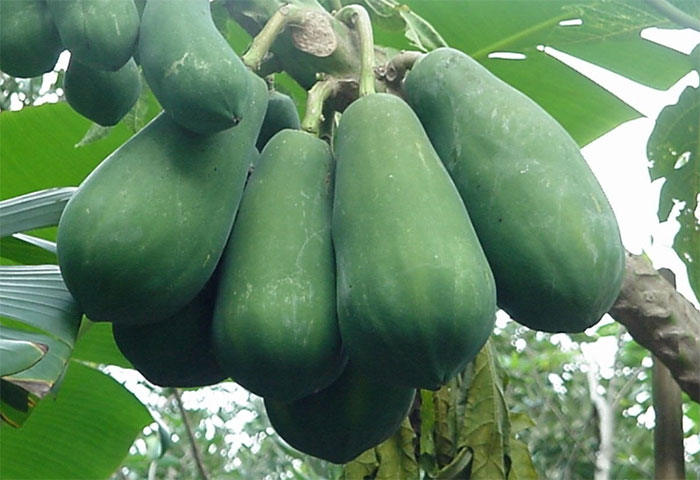Papaya can be considered a “miracle drug,” as many parts of the papaya plant are used not only as food but also as medicine to treat various ailments.
Essential Things to Know When Eating Papaya
In 100g of ripe papaya, there are 74 – 80 mg of vitamin C and 500 – 1,250 IU of carotene. Papaya also contains vitamins B1, B2, enzymes, and minerals such as potassium, calcium, magnesium, iron, and zinc.
Regular consumption of papaya can help improve blood health, assist in liver recovery for those suffering from malaria, provide antioxidant benefits, and boost the body’s immunity. However, both ripe and green papayas can have certain health risks if consumed excessively.
Dangers of Green Papaya

Green papaya is commonly used in various dishes.
Green papaya is often used in soups and salads, but did you know that this fruit also harbors many unexpected dangers if consumed incorrectly? Here are the risks associated with green papaya:
- The seeds of green papaya contain the toxic substance capine, which is harmful to health.
- Excessive consumption of green papaya can lead to kidney stones due to its high vitamin C content.
- Eating too much green papaya may cause stomach disorders because it contains a lot of fiber and latex.
- Consuming green papaya on an empty stomach or during diarrhea can lead to dehydration.
- Allergic reactions may occur from contact with the latex of green papaya.
- Green papaya may increase the risk of uterine contractions due to its latex content. This can adversely affect the fetus, leading to miscarriage, premature birth, or stillbirth.
Dangers of Ripe Papaya

Ripe papaya.
Similar to green papaya, consuming too much ripe papaya can also lead to some unwanted side effects, including:
Reduced Fertility
Ripe papaya contains substances that can reduce sperm count in men. Therefore, if you are planning to conceive, it is advisable to limit your intake of ripe papaya.
Stomach Disorders
Due to its high fiber content, eating too much ripe papaya can lead to symptoms such as stomach pain, nausea, bloating, and gas.
Stomach Pain
The papain in ripe papaya can soothe your stomach, but it may also trigger pain if consumed in large quantities.
Skin Issues
Ripe papaya contains beta-carotene, a nutrient that provides vitamin A to the body. However, excess beta-carotene can cause your skin to appear pale.
Allergic Reactions
If you have respiratory disorders such as asthma or any other allergic symptoms, be cautious when eating papaya. Papaya allergies can cause symptoms like swelling of the mouth, itching around the face and throat, rashes on the tongue, dizziness, headaches, shortness of breath, and difficulty swallowing.
Who Should Avoid Papaya
Despite its many benefits, papaya can be detrimental to the following groups of people:
Individuals with Respiratory Issues
Papaya contains the enzyme papain, a strong allergen that can exacerbate respiratory disorders. People suffering from conditions like hay fever or asthma are advised to avoid this fruit.
People with Kidney Stones
Papaya contains vitamin C, which is essential for maintaining the body’s immune system. However, excessive consumption can lead to vitamin C overload and the formation of kidney stones.
While ripe papaya is considered safe and nutritious, green papaya may increase the risk of uterine contractions due to its latex content. If pregnant women consume green papaya latex, it can adversely affect the fetus, leading to miscarriage, premature birth, or abnormal births.
Individuals with Jaundice
Not only ripe papaya but also pumpkin, carrots, and mangoes contain high levels of beta-carotene. Consuming too many of these foods can lead to yellowing of the palms and soles due to excess beta-carotene. To improve this condition, you should refrain from eating these foods for a while. If the condition does not improve, consult a specialist to identify the cause.
Those with Allergic Conditions
If you suffer from respiratory disorders such as asthma or any allergies, be careful when eating papaya. Pollen may stick to the surface of the papaya, so ensure you wear gloves when peeling it. Dispose of the peel and gloves immediately after peeling. You should also cover your mouth and nose with a cloth to avoid allergies. Papaya allergies can manifest as symptoms such as swelling of the mouth, itching around the face and throat, rashes on the tongue, dizziness, headaches, stomach pain, shortness of breath, and difficulty swallowing.
Precautions When Eating Papaya
Experts say that fermented papaya can lower blood sugar levels in individuals with type 2 diabetes. Diabetes medications are also used to reduce blood sugar levels.
Therefore, consuming fermented papaya along with diabetes medication can cause your blood sugar levels to drop too low.
Additionally, individuals taking blood-thinning medications should be cautious when eating papaya, as it may enhance the effects of the medication, increasing the risk of bruising and bleeding.
It is recommended to consume about 500 – 700 grams of papaya per day. Ripe papaya contains more sugar and calories than green papaya, so balance your diet accordingly when incorporating papaya.
Papaya is a nutritious food with low acidity, making it safe to eat on an empty stomach without harming your stomach. However, if you are on a diet, it is best not to consume it during main meals; instead, enjoy papaya at lunchtime and avoid eating the seeds.
In conclusion, both green and ripe papaya are beneficial for health if consumed correctly and by the right individuals. We hope that with the information shared above, you will know how to moderate your daily papaya intake and limit consumption when facing health issues to avoid the adverse effects of both green and ripe papaya.
















































